Link to my full botanical survey report including 40 species found at Griggs: https://docs.google.com/document/d/1hUwDNg29KvMmcxWZm5AZ0irs8co8q4GT5j4KeMLtn4M/edit?usp=sharing
Although I titled this page plants of Griggs, I’m actually going to start off with a plant not from Griggs, but from Battelle Darby Creek (for educational purposes). As always, I can thank my field guides, professor, and TA for help identifying everything. Any other sources used are mentioned and linked on my page.
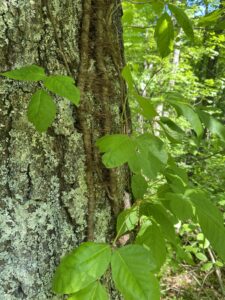 The first plant (and the only one on this page from Batelle) is poison ivy (Toxicodendron radicans). I’m this sure is a fan favorite for most, but I’m going to help you learn to properly identify it.
The first plant (and the only one on this page from Batelle) is poison ivy (Toxicodendron radicans). I’m this sure is a fan favorite for most, but I’m going to help you learn to properly identify it.
To start off, as mentioned in the Battelle Darby Creek page, the area is in the eastern portion of the state, so the soil present is sandstone, shale, and limestone. Since sandstone is weather and erosion resistant (unlike shale), the area is full of valleys and steep hillsides. With all of the limestone present, calcium is abundant too (since the chemical formula is CaCO3, thanks chemistry). The plants that now live in the area have adapted to living in these calcium rich environments, and we call them calciphiles. And to mention the obvious, there is a creek running through Battelle Darby Creek Park, which creates riverside banks with plenty of moisture. Thanks to Metro Parks (Battelle Darby Creek – Metro Parks – Central Ohio Park System), I’ve provided a basic map of the park: Battelle.Darby.Map
Now, I know y’all have heard of ‘leaves of three, let them be’. While this is a good introduction for younger kids, it isn’t the best way to avoid the itch. As Dr. Klips recommended ‘leaflets of the three, let them be’. Personally, I think the best way to identify poison ivy is their aerated roots. “Aerated roots? I thought roots were underground” not for poison ivy! Their roots are on the surface, and in the picture I provided, are climbing up a tree. They look hairy and are not underground. That’s a great thing to avoid. As for the leaves, they don’t have three leaves off the main stem, but three leaflets (leaves branching off a branch that comes off the stem). I also think the leaves kind of look like mittens with a thumb, and they aren’t really symmetrical. Hope this helps prevent contact, and if it doesn’t, most stores sell calamine lotion. Best of luck.
Next on our docket is flowers and their inflorescence type (how the flowers are organized). All of these plants are native to Ohio and have not been artificially cultivated or brought in (perks of being on a nature preserve).
The first flower we’ll look at is the Common Fleabane (Erigeron philadelphicus). Being of the Asteraceae family (with sunflowers), the common inflorescence type is a single flower head made of a bunch of flowers. This one just appears just as a single flower. The capitulum type is a radiate as it has both disks (think of where sunflower seeds are) and rays (what look like typical petals on a flower). The fruit this flower will produce is called an achene (think a literal sunflower seed. Botanist must have wanted to be unique because their term of fruits is for a ripe ovary; to regular people, that’s mostly seeds, grains, and fruits/veggies). It has a gynoecium type of bicarpellate. The stamen (male parts) are fused together in a little tube below the flowerhead (where the ovary is, so it has an inferior ovary compared to petals).
The next flower of the batch is Cow Parsley (Anthriscus sylvestris). This is a member of the Apiaeceae family (literally the parsley family), which is full of common spices and some toxic plants. Other members include dill, fennel, celery, carrots, and poison hemlock. The inflorescence type is a compound of umbels, and the fruit that will grow is a schizocarp (shizo=split). The best example of a schizocarp is parsley, hence why this is called the parsley family; it’s the golden standard, the overachieving sibling if you will. These guys are epigynous (epi=above, gynous=female parts, not just for people) inflorescence. Since the ‘flower parts’ (like petals) start from above (epi-) the ovary (gynous-), it has an inferior ovary type too.
Second to last is the Yellow Flag Iris (Iris pseudacorus). I was super stoked when my boyfriend pointed these out on our adventure, because I’m always a sucker for pretty plants. These plants are three-petaled monocots (mentioned in the Cedar Bogs page with the Southern Flag Iris) just like lilies. Some more fancy terms to describe the flower include: syncarpous (many female parts merged together) and capsule bearing fruits/seed pods(one carpel can split many ways, example is ochre). This plant’s flower is just a single sole flower head (that looks rad).
Last but not least, we have the Butterweed (Packera glabella). This plant, like the Fleabane, is part of the Asteraceae family. It too has a bicarpellate gynoecium, with an inferior ovary, and produces achenes. Achenes are best spread by the wind (think helicopter seeds as a shining example, or overachieving cousin you’re compared to at family events). These flowers are toxic for people so don’t eat them, but I recommend not eating anything you find out on adventures without being 100% confident in either your knowledge or response time of EMS.
As always, I have to include some nasty invasive plants (boo-hiss). I’m sure that if you’re familiar with my blog that you can guess the first foe that will appear on this list. All of these plants are ones I’ve ran into before, and they seem to be a problem in most places in Ohio (I have not found any of them to be isolated or regional).
Shocker, it’s Amur Honeysuckle (Lonicera maackii), a personal enemy of mine (that’s been trying to take over my backyard, too bad I have an axe). Yes I know they smell nice and look pretty, but they’re invasive, out-compete native plants, and are not a sustainable food source for native wildlife. They should be thankful they’re on a nature preserve or something terrible could have happened to them. They’re originally from Asia, and control measures are pretty standard for invasive plants: herbicide (but can get into waterways), hand pulling (time consuming), and controlled burning (can’t isolate to just honeysuckle). I personally just chop them as I see them (where appropriate). Unfortunately, this plant has really taken over portions of Griggs, especially along the creek bank; you can see it overtaking and essentially smothering native trees.
Next on our boo-hiss list is Garlic Mustard (Alliaria officinalis), which is living a lie: it is not in the garlic family, only the mustard family. It has a distinctive smell, and when you pull it out of the ground (because you have beef with plants), it comes out super easily, so easily it almost makes you think it isn’t even anchored in there. I need to get my classmate’s pesto recipe before the end of the semester so I can give these plants a true purpose to serve. Control measures for this Eurpoean-Asian menace is easier than some since it has weak, shallow roots (and cannot grow back just from the roots). Essentially, just yank them “on sight” as the hip kids say.
Second to last is Reed Canary Grass (Phalaris arundinacea). Unlike the other invasive plants, this one isn’t even at least pretty or useful. I also unfortunately did not immediately realize this was invasive until I got home and did more research after my trip. This plant is supposedly native to Europe, but scientists aren’t 100% sure yet; either way, it isn’t native here. Control measures (as brought to you by Invasive Plants of Ohio (oipc.info)) are standard: hand pulling or mowing (time consuming and requires frequent maintenance) and herbicides (should be applied in early spring or late fall to minimize impact to native plants).
Last on the list is yet another common find, the Multiflora Rose (Rosa multiflora). At least this one is pretty, but it sucks seeing a pretty plant, identifying it, and finding out it’s invasive, especially if you see a huge patch of it. Suprise surprise, it’s also of Asian origin (as many invasive flowers are that I’ve met). Control measures for this plant are a bit lackluster; mowing and cutting down, but since this plant tends to grow on hillsides, mowing isn’t always an option. If it’s bad enough, the hillside has to be culled to keep it at bay.
Now that we’ve done our scientifically motivated trash talking, we can move onto the next section of this post, which is woody plants. Typically, we’d like to identify these solely by the fruits they produce, but most of the species I ran into are not producing fruits quite yet; that typically happens more in the late summer and into the fall (think of typical harvest season for most crops).
Our first woody plant is a common Ohio Buckeye (Aesculus glabara). As always, I have to include these in an Ohio based blog. These trees produce distinctive ‘fruits’ or seed pods that have a thick, brown outer coating with a circle of lighter brown on one part of the nut. Though the chocolate and peanut butter buckeyes are tasty, these ones are toxic. Do not eat them. I bet they don’t even taste good. These seeds are an example of capsules; one big seed pod that can contain more than one seed that can split in different ways.
Next up is the American Basswood (Tilia americana). These guys produce a funky looking seed that dangles down from the leaf and holds multiple green-gray berries. They use modified leaves to act as a strap to the bract (leaf appendage) to hold the group of berries up.
Third up on our adventure is the Eastern Redbud (Cercis canadensis). These trees produce those distinctive seed pods that look like someone got a thin slice of banana (cut hotdog way, not hamburger way), dried it up, and turned it brown. Or maybe a big peapod that was dried up and dyed brown. These pods typically contain a few rounded (not kidney shaped like Black Locust) seeds within the pod that will later split open to disperse the seeds.
Lastly, we have the Slippery Elm (Ulmus rubra). These trees produce similar fruits to Rock or Cork Elm, but those have hairs all over, while Slippery Elm only have it on the seed portions (not the casing or anything). The seed cavity reminds me of a heart-shaped peach that’s been shrunken a bit. Kind of cool, but I’m sad to say I didn’t see them in person as they aren’t in season right now, but maybe I’ll go back in the fall and find some.
Last topic for our discussion for this page is moss and lichen. Personally, I did not know that lichen were a composite of multiple organisms; I thought they were their own separate entity. Nope! They’re a combination of fungi (masterminds), bacteria, and algae (fungi food). As Dr. Klips put it, lichen is what happened when fungi discovered agriculture. I always find it cool when I learn that other species so different from us discover ‘human’ practices. In my previous entomology (insects) class, we learnt that there’s some species of insects that have been using agriculture long before we came around (termites I believe are the oldest example). Kind of cool to think about. My talk about moss isn’t as special or mind blowing; moss are nonvascular land plants. They don’t have big trunks and branches that act as plumbing to transport nutrients, so they can’t really get to be giants like some trees.
Presented for your entertainment, I have found three mosses and one lichen. I was actually able to collect moss samples to bring them into our lab for identification (by taking small samples from fallen rocks, or tufts that aren’t attached to a substrate). Since common names aren’t very useful (and can overlap different species), we don’t really use them, only the scientific names. For lichen, since they take their sweet time growing, I left them be and just took pictures of them. Without further ado, I present moss and lichen.
My first moss is Anomodon Rostratus. I found this guy on detached tuft just kind of hanging out on the creek’s bank. It was mostly an orange-yellow color, but I suspect that’s only from it being dried out as the more inner portions were slightly more green color.
My next moss is Amblystegium Varium. This guy was almost like a couple strands of string wrapped around a loose rock (also on the creek bank). It was a lighter green color that wasn’t suer prevalent on the rock, but enough for me to collect to study.
My last moss is one I have not fully identified yet. In fact, Dr. Klips was disgruntled that he couldn’t further help me figure it out, so he took the mossy rock to study more in depth to analyze. This moss was sitting on the top of a rock, almost like a head of hair. This moss was a pretty dark green and fairly think coating. This rock was not balding anytime soon. I hope he figures it out, because I was unable to determine who it was with my guides.
Lastly, I present my lichen. I found this one on a fallen tree branch that was near the bank, but not within it. The lichen is a typical greenish-gray color, and I believe the type is foliose (it looks like leaves and is mostly flat). My guess as to its identification is Common Greenshield Lichen (Flavoparmelia caperata). This identification was made with the help of my field guide ‘Common Lichens of Ohio’ from the Ohio Division of Wildlife (not a sponsored post…yet). Rememeber, don’t remove lichen from its home, just take pictures.

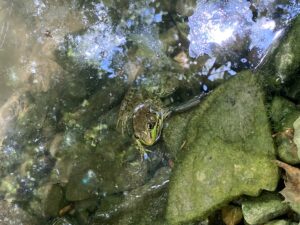
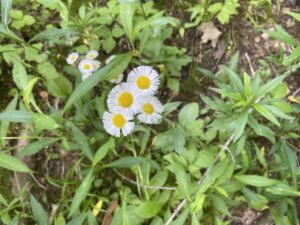
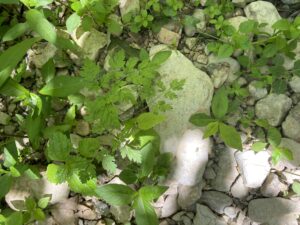
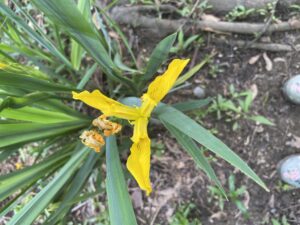
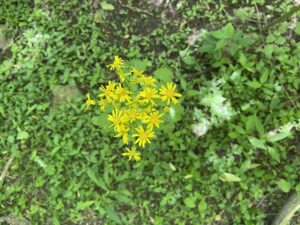
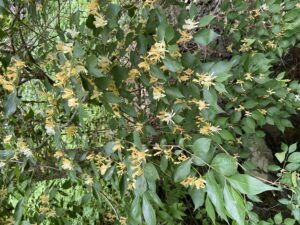
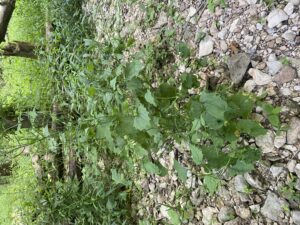

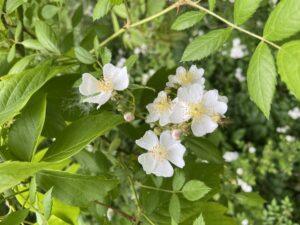
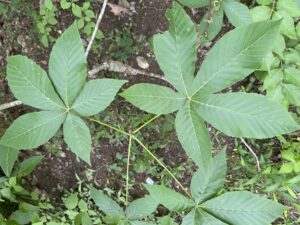
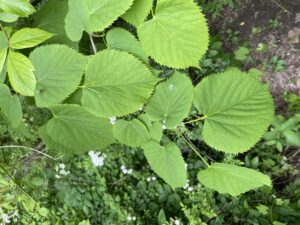

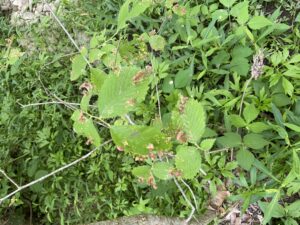
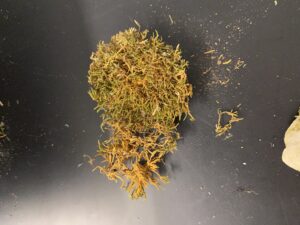
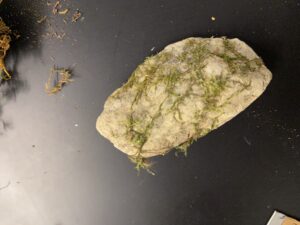
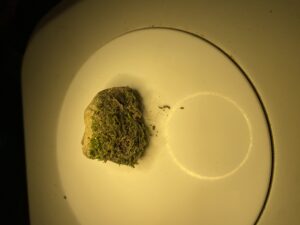
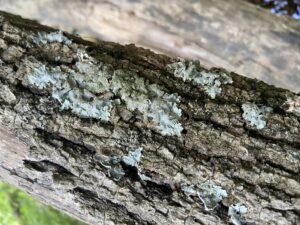
Comments
Plants of Griggs Nature Preserve (Bonus Botanical Survey) — No Comments